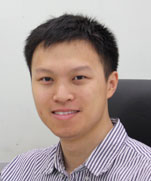Topic: Tunable negative magnetoresistance in hydrogenated graphene
Speaker: Jian-Hao Chen(陈剑豪)
International Center for Quantum Materials, School of Physics, Peking University, Beijing 100871, P. R. China
Collaborative Innovation Center of Quantum Matter, Beijing 100871, P. R. China
Time:2016年9月14日(周三) 15:00
Venue:李薰楼468室
Abstract:
The problem of unconventional magnetism in materials without d and f electrons has attracted continuous attention. In particular, a lot of efforts have been devoted to understand the origin and effects of magnetic moments induced in graphene with structure defects such as missing carbon atoms, absorption of light atoms such as hydrogen or fluorine. We have measured the magnetoresistance (MR) of graphene at low temperature with in-situ hydrogenation in ultra-high vacuum environment. Large negative MR was found in hydrogenated graphene which could be tuned by carrier density and sample temperature. Depending on the density of absorbed atomic hydrogen and carrier density, large linear negative MR was found which did not saturate up to 9 Tesla. Such negative MR could be the manifestation of local moments created by atomic hydrogen absorbed on graphene.
Brief Biography:
 Dr. Jian-Hao Chen obtained his PhD in Physics under the supervision of Prof. Ellen Williams at University of Maryland at College Park, Maryland, United States in 2009. Thereafter, he worked as a Research Fellow in the nanoelectronics group of Prof. Michael Fuhrer at University of Maryland and in Prof. Alex Zettl’s group at University of California at Berkeley. Since March 2013 he joined Peking University as an Associate Professor and Principle Investigator of the Laboratory for Nanoelectronics and In-Situ Quantum Transport. His present research is focused on studying the physics and applications of low-dimensional electronic materials and its nanostructures, manipulation of material properties at the atomic scale, and in-situ quantum electrical transport in ultra-high vacuum environment. His peer-reviewed publications include three articles in Nature Physics, one article in Nature Nanotechnology and three articles in Physical Review Letters, with a total SCI citation of more than 4000.
Dr. Jian-Hao Chen obtained his PhD in Physics under the supervision of Prof. Ellen Williams at University of Maryland at College Park, Maryland, United States in 2009. Thereafter, he worked as a Research Fellow in the nanoelectronics group of Prof. Michael Fuhrer at University of Maryland and in Prof. Alex Zettl’s group at University of California at Berkeley. Since March 2013 he joined Peking University as an Associate Professor and Principle Investigator of the Laboratory for Nanoelectronics and In-Situ Quantum Transport. His present research is focused on studying the physics and applications of low-dimensional electronic materials and its nanostructures, manipulation of material properties at the atomic scale, and in-situ quantum electrical transport in ultra-high vacuum environment. His peer-reviewed publications include three articles in Nature Physics, one article in Nature Nanotechnology and three articles in Physical Review Letters, with a total SCI citation of more than 4000.



